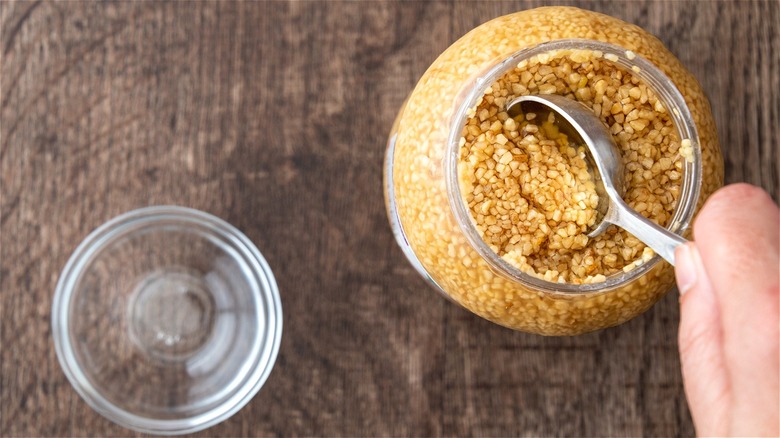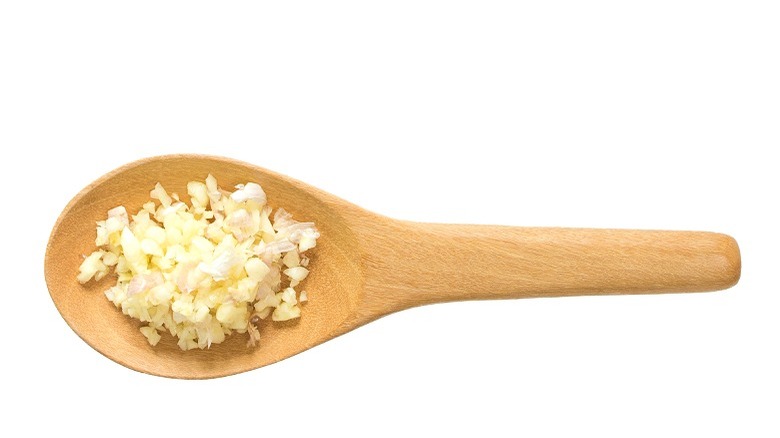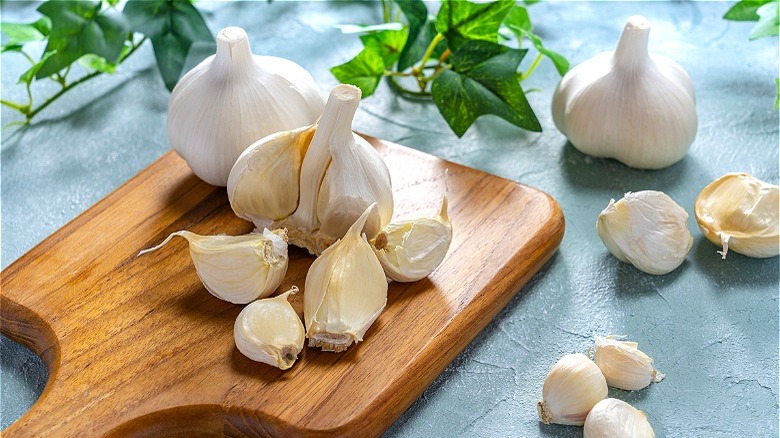Does Minced Garlic Go Bad After It's Opened?
For many at-home chefs, there are a few things better than smelling the distinct aroma of minced garlic sautéing in butter or olive oil on the stove. If you ever wondered how such a prominent smell and taste can come from such a small plant, The Garlic Farm blames allicin, which is a sulphuric compound only produced when a garlic clove is minced or crushed. The process of altering the clove creates a chemical reaction that produces that one-of-a-kind smell and taste we've come to know and love in many of today's savory dishes.
Garlic's consistent presence behind the scenes in restaurant kitchens and at-home recipe ingredient lists makes it a popular food for enhancing the other ingredients on your plate. According to the USDA, in 2020, U.S. farmers produced roughly 346 million pounds of garlic. But things get interesting when you discover that not even half of that amount was sold as a fresh product. 225 million pounds of garlic were processed into various products, such as garlic powder and dehydrated garlic.
With the difficulty of peeling raw garlic cloves, you may have turned to jarred garlic to save your sanity. But how can you tell if that ancient bottle in the back of your fridge is still good to use?
Is older minced garlic safe to use?
To answer this question, there are a few factors to consider. Jarred garlic is a popular product you can find in almost every grocery store. But with abundance comes variety. If your jarred garlic contains preservatives, an opened bottle will remain safe to eat for up to 24 months if sealed properly in your refrigerator. Preservatives aside, both FoodsGuy and Street Smart Kitchen agree that you're typically safe to consume opened jarred garlic for up to 3 months when it's stored in your fridge after opening. (While expiration dates are important, they're usually indicators of garlic quality, not safety.)
If you're unsure of when you purchased the garlic in question, there are signs to look for in terms of spoilage. FoodsGuy states that if your jarred garlic has an off-putting smell or signs of discoloration, it might be time to say goodbye.
You might have a habit of keeping the jarred variety handy to make your famous garlic rolls, but Healthy Food Guide says that buying pre-minced garlic is a gamble due to the array of ingredients that can be added, such as vegetable gums, salt, and sugar. But is there really that much of a difference between jarred garlic and cloves straight from the bulb?
Jarred garlic versus fresh garlic
Everyone has an opinion when it comes to food, especially in regard to one of America's favorite meal enhancers. The late Anthony Bourdain even boldly stated in "Kitchen Confidential," "Too lazy to peel fresh? You don't deserve to eat garlic" (via The Walrus). Beyond the pure judgment you might face in choosing jarred over fresh, is there a real taste difference between the two options?
According to Better Homes & Gardens, one clove of garlic roughly equates to one-half teaspoon of the pre-minced variety. The jarred version tends to be milder in flavor, so BHG advises consumers to use more if they're after a more robust flavor. Cooks Illustrated took things a step further and measured three fresh garlic alternatives to judge which one came out as the best-tasting substitute. When minced garlic, pre-peeled cloves, and garlic paste were put to the test, the cloves had the best flavor. Cools Illustrated claimed the pre-minced option produced "off-flavors."
Furthermore, there's research to back up the mild flavor of jarred garlic. In one 2008 study, the chemical compound that is produced upon mincing or crushing garlic, allicin, was found to degrade over time when placed in water and alcohol solutions. In oil, specifically, allicin's stability dropped by half the typical amount when compared to fresh-cut garlic. Taste aside, as long as your jarred variety is showing no signs of spoilage, it's fine to use.


